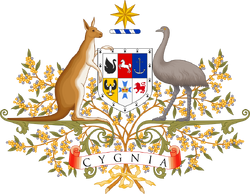| Democratic Republic of Cygnia | ||||||
| Timeline: Joan of What? | ||||||
| ||||||
| ||||||
| Motto Labour, Truth and Courage | ||||||
| Anthem State Anthem of the Democratic Republic of Cygnia | ||||||
| Capital | Swanstone | |||||
| Languages | English | |||||
| Religion | State atheism | |||||
| Government | Unitary Marxist-Leninist single-party state (de jure) Totalitarian single-party dictatorship (de facto) | |||||
| Chancellor | ||||||
| - | 1934 — 1943 | Franklin Jonathan Heller | ||||
| Chief Minister | ||||||
| - | 1934 — 1936 | Jonathan Mulberry | ||||
| - | 1936 — 1938 | Benjamin Wellington | ||||
| - | 1938 — 1943 | Frederick Poole | ||||
| - | 1943 | Max Nielsen | ||||
| General Secretary | ||||||
| - | 1934 — 1943 | Franklin Jonathan Heller | ||||
| Legislature | Supreme People's Congress | |||||
| History | ||||||
| - | Coup d'état | 3 May 1933 | ||||
| - | Proclamation of Democratic Republic | 5 May 1934 | ||||
| - | World War III | 1 September 1939 | ||||
| - | Cygnian Revolution | 3 March 1943 | ||||
| - | Armistice | 8 May 1945 | ||||
| Currency | Cygnian Dollar | |||||
The Democratic Republic of Cygnia, known contemporarily as Cygnia and otherwise as Hellerist Cygnia when in conjunction with other political entities in Cygnian history, was the totalitarian single-party dictatorship of Marshal Franklin Jonathan Heller as Chancellor, and his National Cygnian Socialist Party. The Republic replaced the First Empire following a violent massacre carried out by Heller's agents in the Imperial Palace on 3 May 1933, resulting in the deaths of all Imperial Family members resident save the Prince Ellory, the youngest son of then-Emperor Theodore IV. The former escaped the attention of his family's murderers.
The murder prompted Chancellor Sir Wesley Orwell declared a national emergency, which granted him heightened powers and enacted martial law across the country; this was an expected response from the Imperial Government. The Chancellor was framed, and the blame placed on him for the deaths of the Imperial Family. As a result, Chancellor Orwell was arrested by troops from the Army and sentenced to death for treason in a show trial staged by Marshal Heller. The NCSP than ran in the federal elections scheduled for 1934. After a campaign of intimidation and corruption, the Socialist Party secured a landslide victory of 338 and 214 seats in the National Assembly and Senate respectively. This election is today considered invalid and illegal due to the total absence of the secret ballot system and use of intimidation to frighten voters.
Immediately after the opening of the next Congress, the Socialist Assembly Leader Scott Tanner introduced a bill which was carried 353 to 27, and then passed by the Senate 215 to 25. Many Senators in the minority parties objected. As Democratic Labour Party Assembly Leader said at that Senate meeting, "Fellow Senators, do you not see what is before us today? Do you not see that the Socialists are plotting the downfall of all we hold dear? Should this bill proceed to the Chancellor, Congress will be disbanded and Cygnian Democracy will be destroyed. Cygnian Values will be destroyed. Cygnian Lives will be destroyed. Cygnia herself will be destroyed if this bill proceeds." As such, 25 of the 26 non-Socialist Senators voted in opposition to the bill. It carried anyway, and was signed into law by Chancellor Heller on 5 May 1934, with immediate effect. The Act permanently dissolved Congress and the Constitution, and instituted single-party rule for the Socialists. For the next nine years, Heller and his Party worked to expand the military, though at the grave cost of many other sectors of government. Although the military had reached record numbers by 1939, equipment was vastly inadequate and troops were generally under-trained. In the meantime, public unrest was often put down violently by police and military authorities.
The outbreak of war with Australie in 1939 proved just how unprepared Cygnia was for military conflict. Thousands of Cygnian lives were lost as Australien troops stormed over the border, seizing vast swaths of territory and raiding Cygnian border towns.
By 1943, Australie had split Cygnian territory into two as they reached the coastal city of Theodora. In the south were the core territories, including the capital, Swanstone. In the north were Samudra and Java. The dramatic loss of land and resources spelt doom for Cygnia's economy, and it soon crashed. General rioting and unrest followed; soldiers began refusing to fight because of the lack of payment and food. To make matters worse for Heller's government, 21-year-old Prince Ellory had re-emerged from hiding and had assumed the leadership of a newborn rebel movement. 3 March marked the beginning of the Cygnian Revolution as disgruntled citizens flocked to the side of the Prince. The March on Swanstone on 8 April 1943 proceeded with little resistance and the members of the Hellerist government were arrested. The Republic came to a swift end soon after as Prince Ellory took over as head of the Armed Forces and later of the peace delegations that ended the Australasian Front of World War III in 1945.
| |||||||||||||||||||||||
| ||||||||||||||



